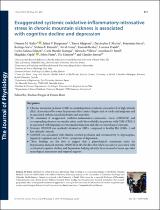Mostrar el registro sencillo del ítem
Exaggerated systemic oxidative-inflammatory-nitrosative stress in chronic mountain sIckness is associated with cognitive decline and depression
| dc.contributor.author | Bailey, Damian M | |
| dc.contributor.author | Brugniaux, Julien V | |
| dc.contributor.author | Filipponi, Teresa | |
| dc.contributor.author | Marley, Christopher J | |
| dc.contributor.author | Stacey, Benjamin | |
| dc.contributor.author | Soria, Rodrigo | |
| dc.contributor.author | Rimoldi, Stefano F | |
| dc.contributor.author | Cerny, David | |
| dc.contributor.author | Rexhaj, Emrush | |
| dc.contributor.author | Pratali, Lorenza | |
| dc.contributor.author | Salinas Salmón, Carlos | |
| dc.contributor.author | Murillo Jáuregui, Carla | |
| dc.contributor.author | Villena, Mercedes | |
| dc.contributor.author | Smirl, Jonathan D | |
| dc.contributor.author | Ogoh, Shigehiko | |
| dc.contributor.author | Pietri, Sylvia | |
| dc.contributor.author | Scherrer, Urs | |
| dc.contributor.author | Sartori, Claudio | |
| dc.date.accessioned | 2021-07-15T14:08:21Z | |
| dc.date.available | 2021-07-15T14:08:21Z | |
| dc.date.issued | 2019 | |
| dc.identifier.uri | http://repositorio.umsa.bo/xmlui/handle/123456789/25615 | |
| dc.description.abstract | Abstract. Chronic mountain sickness (CMS) is a maladaptation syndrome encountered at high altitude (HA) characterised by severe hypoxaemia that carries a higher risk of stroke and migraine and is associated with increased morbidity and mortality. The present cross‐sectional study examined to what extent exaggerated systemic oxidative‐inflammatory‐nitrosative stress (OXINOS), defined by an increase in free radical formation and corresponding decrease in vascular nitric oxide (NO) bioavailability, is associated with impaired cerebrovascular function, accelerated cognitive decline and depression in CMS. Venous blood was obtained from healthy male lowlanders (80 m, n = 17), and age‐ and gender‐matched HA dwellers born and bred in La Paz, Bolivia (3600 m) with (CMS+, n = 23) and without (CMS−, n = 14) CMS. We sampled blood for oxidative (electron paramagnetic resonance spectroscopy, HPLC), nitrosative (ozone‐based chemiluminescence) and inflammatory (fluorescence) biomarkers. We employed transcranial Doppler ultrasound to measure cerebral blood flow (CBF) and reactivity. We utilised psychometric tests and validated questionnaires to assess cognition and depression. Highlanders exhibited elevated systemic OXINOS (P < 0.05 vs. lowlanders) that was especially exaggerated in the more hypoxaemic CMS+ patients (P < 0.05 vs. CMS−). OXINOS was associated with blunted cerebral perfusion and vasoreactivity to hypercapnia, impaired cognition and, in CMS+, symptoms of depression. Collectively, these findings are the first to suggest that a physiological continuum exists for hypoxaemia‐induced OXINOS in HA dwellers that when excessive is associated with accelerated cognitive decline and depression, helping identify those in need of specialist neurological assessment and support. | es_ES |
| dc.language.iso | en | es_ES |
| dc.publisher | J Physiol | es_ES |
| dc.subject | ESTRÉS OXIDATIVO-INFLAMATORIO | es_ES |
| dc.subject | MAL CRÓNICO DE MONTAÑA | es_ES |
| dc.subject | DETERIORO COGNITIVO | es_ES |
| dc.subject | DEPRESIÓN | es_ES |
| dc.title | Exaggerated systemic oxidative-inflammatory-nitrosative stress in chronic mountain sIckness is associated with cognitive decline and depression | es_ES |
| dc.type | Article | es_ES |

